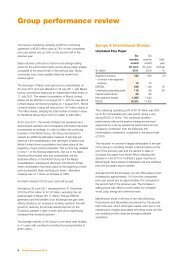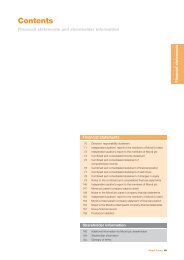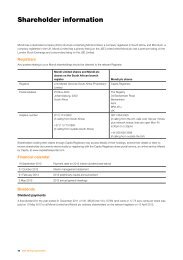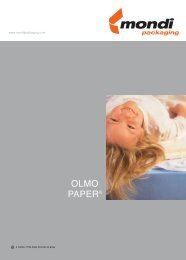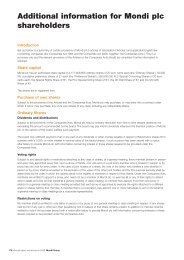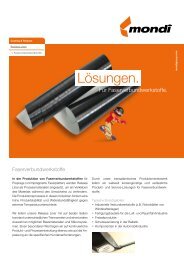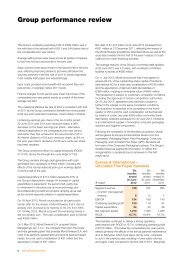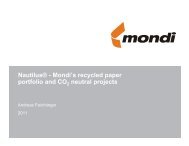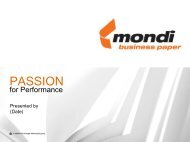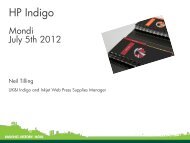Mondi Limited
Mondi Limited
Mondi Limited
You also want an ePaper? Increase the reach of your titles
YUMPU automatically turns print PDFs into web optimized ePapers that Google loves.
Notes to the financial statements and<br />
consolidated financial statements<br />
continued<br />
for the year ended 31 December 2010<br />
1 Accounting policies (continued)<br />
Impairment of goodwill<br />
Goodwill arising on business combinations is allocated to the group of cash-generating units that are expected to benefit from the<br />
synergies of the combination and represents the lowest level at which goodwill is monitored by the board for internal management<br />
purposes. The recoverable amount of the group of cash-generating units to which goodwill has been allocated is tested for<br />
impairment annually on a consistent date during each financial year, or when events or changes in circumstances indicate that it<br />
may be impaired.<br />
Any impairment is recognised in the consolidated income statement. Impairments of goodwill are not subsequently reversed.<br />
Non-current non-financial assets excluding goodwill, deferred tax and retirement benefits surplus<br />
Property, plant and equipment<br />
Property, plant and equipment comprise land and buildings, property, plant and equipment and assets in the course of<br />
construction.<br />
Property, plant and equipment is stated at cost less accumulated depreciation and impairment losses. Cost includes all costs<br />
incurred in bringing the assets to the location and condition for their intended use and includes borrowing costs incurred up to the<br />
date of commissioning.<br />
Depreciation is charged so as to write off the cost of assets, other than land, and assets in the course of construction, over their<br />
estimated useful lives to their estimated residual values.<br />
Assets in the course of construction are carried at cost, less any recognised impairment. Depreciation commences when the<br />
assets are ready for their intended use. Buildings and plant and equipment are depreciated to their residual values at varying rates,<br />
on a straight-line basis over their estimated useful lives. Estimated useful lives range from three years to 20 years for items of plant<br />
and equipment and to a maximum of 50 years for buildings.<br />
Residual values and useful lives are reviewed at least annually.<br />
Assets held under finance leases are capitalised at the lower of cash cost and the present value of minimum lease payments at the<br />
inception of the lease. These assets are depreciated over the shorter of the lease term and the expected useful lives of the assets.<br />
Licences, other intangibles and research and development expenditure<br />
Licences and other intangibles are measured initially at purchase cost and are amortised on a straight-line basis over their<br />
estimated useful lives. Estimated useful lives vary between three years and ten years and are reviewed at least annually.<br />
Research expenditure is written off in the year in which it is incurred. Development costs are reviewed annually and are recognised<br />
as an expense if they do not qualify for capitalisation. Development costs are capitalised when the completion of the asset is both<br />
commercially and technically feasible and is amortised on a systematic basis over the economic life of the related development.<br />
Impairment of tangible and intangible assets excluding goodwill<br />
At each reporting date, the Group and Company review the carrying amounts of its tangible and intangible assets to determine<br />
whether there is any indication that those assets are impaired. If any such indication exists, the recoverable amount of the asset is<br />
estimated in order to determine the extent of the impairment, if any. Where the asset does not generate cash flows that are<br />
independent from other assets, the Group and Company estimate the recoverable amount of the cash-generating unit to which the<br />
asset belongs.<br />
The recoverable amount of the asset, or cash-generating unit, is the higher of its fair value less costs to sell and its value-in-use. In<br />
assessing value-in-use, the estimated future cash flows generated by the asset are discounted to their present value using a<br />
discount rate that reflects current market assessments of the time value of money and the risks specific to the asset for which<br />
estimates of future cash flows have not been adjusted.<br />
22 Annual report and accounts 2010



